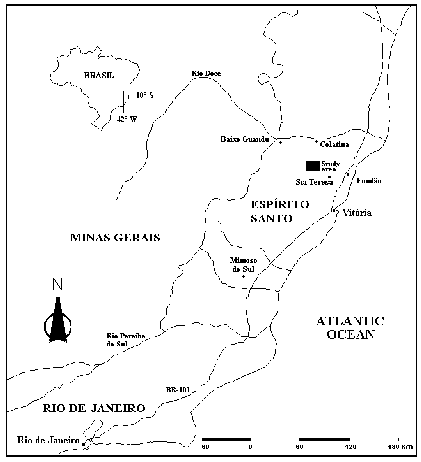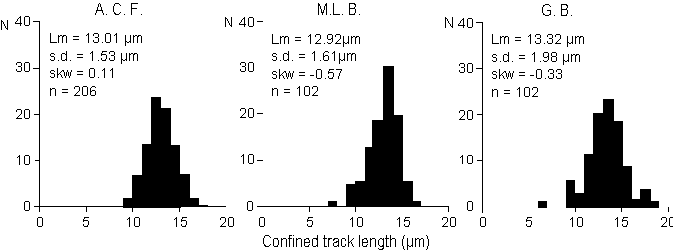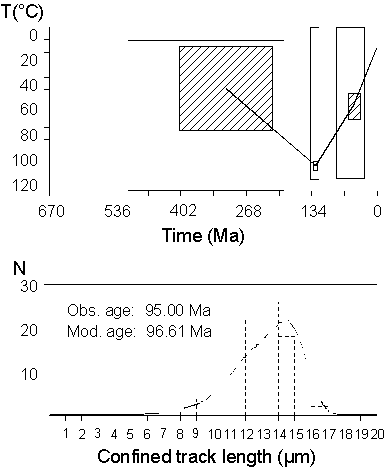APATITE FROM AN OLIVINE PYROXINITE OF CANAÃ VALLEY, ESPÍRITO SANTO, BRAZIL: FISSION-TRACK AGE DETERMINATION AND CONFINED TRACK LENGTH MEASUREMENTS IN ORDER TO ESTABLISH NA INTERNAL STANDARD
Ariadne do Carmo Fonseca*, Maria Laura Balestrieri**, Giulio Bigazzi*** and Pio Norelli***
(*) Departamento de Geologia, Universidade Federal do Ceará, CP 6032, Campus do Pici, 60451-970, Fortaleza, Ceará.
(**) Dipartimento di Scienze della Terra, Università di Firenze, via La Pira, 4, 50121 Firenze.
(**) Istituto di Geocronologia e Geochimica Isotopica, CNR, via Cardinale Maffi, 36, 56127 Pisa.
ABSTRACT
We present the first results of fission-track age determinations and natural confined track length measurements in apatite crystals of an olivine pyroxenite from the Canaã Valley, Espírito Santo, Brazil. This apatite was chosen for its high abundance in the rock and also for its high uranium content. Confined track length measurements were performed by three different analysts, whereas fission-track ages corresponding to two different irradiations were determined by two analysts. Confined track length distributions as well as ages showed good reproducibility. The characteristics of this apatite (its abundance in the rock and the relatively large number of confined tracks) make it a very promising internal standard which experienced a more complex thermal history in comparison with the volcanic apatite international age standards. The fission-track age of around 95 Ma of the apatite sample from the olivine pyroxenite is consistent with the age interval 65-110 Ma previously measured by Fonseca and Poupeau (1984), Fonseca (1989) and Fonseca et al. (1992) in the Ribeira Belt. This age interval corresponds to the basaltic and alkaline volcanic activities related to the opening of the Atlantic Ocean.
Keyboards: fission-track dating, apatite, olivine pyroxenite, Canaã Valley, Espírito Santo, Brazil
INTRODUCTION
The use of reference samples allows to test and improve accuracy of analytical methodologies. In fission-track dating, the Subcommission on Geochronology of the International Union of Geological Sciences (I.U.G.S.) established that age standards should form the basis of all system calibrations (Hurford 1990). This is the only way to compare measurements performed by different analysts and/or different methodologies. Only two apatite samples are recommended as standard by the Subcommission on Geochronology of I.U.G.S., the Fish Canyon Tuff apatite and the Durango apatite. The first is distributed by C.W. Naeser, from the U.S. Geological Survey, and only very small aliquots are supplied. The Durango apatite is a mineral for collection. Another additional standard, distributed by A.J. Gleadow (La Trobe University, Melbourne, Australia) is the apatite from Mount Dromedary Intrusive Complex.
Due to poor thermal stability of fission tracks in apatite, this mineral phase yields the formation age of the rocks only in case of fast cooling after their emplacement (in practice, in case of volcanic rocks). On the contrary, when a rock experienced after its emplacement temperatures higher than around 60°C during a time not negligible compared to its age, the fission-track age that one can measure is aminimum age. In practice, there is a temperature interval, approximately between 60°C e 110°C, named partial annealing zone, in which fission tracks are only partially retained. The amount of track length reduction increases with the temperature, and for temperatures > 110°C tracks are totally unstable.
Considering that the spontaneous fission of 238U occurs at a constant rate during time, each track experienced a peculiar part of the thermal history of the rock. The track length distribution it is possible to decipher the time - temperature path of the rock since it cooled below 110°C. For this reason, the apatite fission-track analysis (AFTA), combination of age determination and track length measurement, turned to be an efficient tool for thermochronological studies.
Therefore, accuracy of track length measurements is also important and the use of standard samples may greatly contribute to their optimisation. A reference sample-set should include apatites that experienced different thermal histories, including those more complex than the simple fast cooling corresponding to the volcanic apatites Fish Canyon Tuff and Durango. In this work we present the first results obtained in an apatite chosen for its abundance in the host rock and for its high uranium fission-track density, with the aim to adopt it as an internal standard for reproducibility tests and for comparisons of measurements performed by different analysts and/or with different equipments.
GEOLOGICAL SETTING
The apatite used for this study was extracted from an olivine pyroxenite, outcropping in the Canaã Valley, near the village of Santo Antônio, Espírito Santo (Fig. 1). This olivine pyroxenite belongs to the Pre-Cambrian Unit Î Yolpx, including the group of late to post transcurrent acid and basic intrusions in the Colatina map, published by the Companhia de Pesquisa de Recursos Mineriais - CPRM (Company of Research of Mineral Resources; Tuller 1993). This rock outcrops as a small circular body about 1 Km2. To the north, west and east this grey-greenish coloured body is in contact with the regional aluminum gneisses, whereas to the south it is in contact with the hedenbergitic Santa Tereza gneiss. The rock is isotropic, medium grained and it is cut by quartz and feldspar veins. It does not show significant deformation, although this rock is involved in a big folded structure, probably produced by its own empalcement.

Figure 1 –
Location map of the study area.Mineralogical and petrographical determinations
As a detailed mineralogical and petrographical study of the olivine pyroxenite from the Canaã Valley is not the aim of this work, only a short account is given here. The rocks is formed by olivine, clino and orthopyroxene, hornblende, mica, plagioclase, apatite and opaque minerals. X-ray diffraction analyses allowed to characterise fayalite olivine, orthopyroxene ferrossilita, clinopyroxene augite and flogopite mica. Analysis of polished sections revealed that the present opaque minerals are pyrrhotite, pentlandite, calco-pyrite and calcocita.
The mineralogical and petrographical determinations were performed in the Laboratório de Difração e Fluorescência de Raios-X do Departamento de Geologia da Universidade Federal do Rio de Janeiro.
SAMPLE PREPARATION
Separation of the various mineral phases was performed sequentially by crushing (jaws), quartering, grinding, washing and drying and sieving (100, 160, 250 mm and remainder)
For each fraction the following procedure was carried out: (1) magnet ® for extraction of pyrrhotite and pentlandite; (2) Frantz magnetic separator ® for extraction of the following mineral phases: flogopite, clinopyroxene + hornblende, orthopyroxene + hornblende, olivine and diamagnetic minerals; and (3) heavy liquid (sodium politungstate) ® for separation of the light (plagioclase) and heavy (apatite) phases.
An aliquot of the apatite crystals population was heated (2 hours at 500°C) to erase natural fission tracks accumulated during geological time. This aliquot was divided into two fractions that were separately irradiated in the Lazy Susan facility of the Triga Mark II nuclear reactor of the University of Pavia, Italy. After irradiation, three fractions from the apatite grain population (one containing natural tracks, for measurement of spontaneous track lengths and areal density, and two irradiated, for induced track areal density determination) were mounted in epoxy, polished and etched (HNO3 5% for 45 seconds at room temperature).
EXPERIMENTAL RESULTS
Fission-tracks commonly used for termochronological studies based on track length distributions are those wholly contained within the apatite crystals, etched through fractures or other tracks These are named "confined tracks". Therefore, the number of confined tracks is rather limited compared to tracks intercepting the polished surface. Anyway, as confined tracks yield their full length, even a small number of them may be enough to inform on thermal histories. However, at least 100 lengths are measured, when possible. This number is commonly adequate for representing a length distribution.
In this work we used an instrument which is alternative to the more popular system digital tablet – microscope equipped with light camera. This is a Leitz Orthoplan microscope coupled to Microvid accessory. The image produced by the lens of the microscope is superimposed to the image of a small monitor. The mouse of the computer drives a small reference cross that has to be placed at the end of the object to be measured. A click of the mouse and the displacement of the cross to the other end of the object produces a line segment whose length is displayed on the monitor. This system is very practical and quick, and has the advantage that segments corresponding to determinations made previosuly remain on the screen. In this way it is possible to verify each measurement.
Confined track lengths measured by three analysts (A. C. F, M.L. B. and G. B.) are shown in figure 2. The first two analysts obtained very similar results and the third analyst (G. B.) determined slightly longer mean length with higher standard deviation. However, the difference can not be regarded as significant.
The age determinations were made by two analysts (A. C. F. and G. B.), using a Leitz Orthoplan microscope and a Jena Jenaval microscope, respectively. Results are shown in Table 1. Reproducibility of age determinations turned to be excellent, as age values obtained by different analysts with different equipments and using different irradiated fractions of the sample are very consistent.
Figure 2 – Confined track length distributions (normalised to 100) measured by three analysts in the Canaã Valley apatite.
Lm: mean length; s.d.: standard deviation; skw: skewness coefficient; N: number of measurements.

Table 1
– Fission-track age determination of an apatite sample from an olivine pyroxenite from the Canaã Valley, Espírito Santo, Brazil.|
Analyst |
r S (x106)(cm-2) |
nS |
s’S (%) |
F (cm-2) |
r i (x106) (cm-2) |
ni |
s’S (%) |
Age ± 1 s (Ma) |
|
A. F. C. |
5.586 |
5,062 |
1.9 |
2.52 x 1015 |
7.352 |
6,662 |
1.8 |
94.6 ± 2.5 |
|
|
|
|
|
2.42 x 1015 |
7.050 |
3,194 |
2.5 |
94.6 ± 3.0 |
|
G. B. |
4.984 |
3,165 |
2.9 |
2.52 x 1015 |
6.459 |
2,461 |
2.7 |
96.1 ± 3.8 |
|
|
|
|
|
2.42 x 1015 |
6.624 |
2,524 |
2.9 |
89.8 ± 3.7 |
r
S (rI): spontaneous (induced) track areal density; nS (nI): number of spontaneous (induced) tracks counted; F: neutron fluence (referred to the new standard glass IRMM-540); s’S (s’I): standard error of the spontaneous (induced) track counts. The error of the age is propagation of the errors of the track densities. Age determinations were made using the population method. Parameters used for age calculation: s = 5.802 x 10-22 cm2; l = 1.55125 x 10-10 a-1, lF = 8.46 x 10-17 a-1.
FISSION-TRACK AGE
The fission-track age of around 95 Ma of the apatite sample from the olivine pyroxenite is consistent with the age interval 65-110 Ma previously measured by Fonseca and Poupeau (1984), Fonseca (1989) and Fonseca et al. (1992) in the Ribeira Belt. This age interval corresponds to the basaltic and alkaline volcanic activities related to opening of the Atlantic Ocean. During Gondwana fragmentation, the continental margins of Africa and Brazil experienced continuous uplift related to lithosphere doming, and voluminous extrusion occorred.
The upward movement and the related erosion processes brought deep seated rocks to more superfacial crustal levels. In this way, metamorphic and igneous rocks of the Pre-Cambrian basement were exposed to lower pressure-temperature conditions.
The brittle behaviour of these rocks that produced structural lows and highs during the tectonic activity related to the opening of the ocean, indicates that they had already cooled, in comparison with their formation temperature, when theybrought to the surface. During the upward movement the Pre-Cambrian basement rocks cooled below the 110°C isotherm and fission-track retention started. Consequently, the fission-track analysis of apatite from the present continental margins allowed to study timing and characteristics of their exhumation.
A comparable apatite fission-track age interval (65-110 Ma) had been determined for the oriental margins of the Atlantic Ocean, in south-western Africa (Haack 1976).
To extract more information on the thermal history of the host rocks of the apatite from the Canaã Valley, we applied the Monte Trax computer modelling (Gallagher 1995). This software yields the time-temperature paths most consistent with the measured fission-track analytical data.
According to Gallagher et al. (1994), who analysed apatite samples from the continental margin of south-eastern Brazil, we selected four time-temperature points, including the present surface mean temperature of 20°C. For the remaining three points, a wide temperature interval was chosen, between surface temperatures up to temperatures corresponding to apatite fission-track total annealing. For the first point, time was left free to vary between 500 and 200 Ma. For the second, the time interval is rather narrow (between 120 and 140 Ma), since it represents the age of the eruption of the Paraná Basin basalts. A post-eruption point follows, in the time span between 100 and 20 Ma.
The genetic algorithm procedure was used, with generation of 50 time-temperature paths for each of 10 iterations. The thermal history which best fits with the experimental results is shown in figure 3. The wide limits of the box, weighted mean of the iterations ± 1s, which represents the first point, indicate that this procedure did not constrain the history prior to around 130 Ma. The best fit time-temperature path of figure 3 suggests that the rocks experienced temperatures close to those corresponding to fission-track total annealing during eruption of the basalts and beginning of the sea-floor spreading of the South Atlantic Ocean. Rocks cooled by at least ca. 80°C during the last 130 Ma.
Figure 3 – Thermal history produced by application of Monte Trax modelling (Gallaghe, 1995). For the confined track length distribution, we have chosen the mean histogram of those shown in Fig. 2. The continuous line represents the best fit of the experimental results. The large boxes represent the limits imposed for choosing time-temperature points during the modelling procedure. The grey boxes represent the ± 1s limits of the weighted mean of the time-temperature paths produced by Monte Trax. The horizontal dashed lines are the limits of the partial annealing zone.
Id. Obs.age: Observed age; Mod.age: age produced by the modelling procedure.

CONCLUSIONS
The apatite from the Canaã Valley olivine pyroxenite studied in this work shows a high track areal density which turns to be very useful for testing counting strategies. This sample allows to measure, in a relatively short time, a large number of confined track lengths. Population method fission-track ages as well as confined track length distributions showed good reproducibility. The thermal history deciphered by the apatite fission-track analysis was well consistent with geological information. For these reasons we consider this apatite, which experienced a more complex history than simple fast cooling, as a very promising additional reference material for the comparison of measurements performed by different analysts and/or using different equipments as well as for testing various computer programs used in apatite fission-track analysis.
Considering its high track density, this apatite may be very useful also for tests related to the alternative dating technique named External Detector Method.
ACKNOWLEDGEMENTS
We wish to thank Maria Cristina Wiedemann (Rio de Janeiro) who supplied the olivine pyroxenite sample, for her help with opaque mineral determination, Isabel Pereira Ludka for X-ray diffractometry analyses and Julio Cesar Mendes for his help with petrographic studies.
This work was partially supported by a grant of the Brazilian National Council of Research and Scientific Development (CNPq).
REFERENCES
BALESTRIERI M. L., BIGAZZI G., FONSECA, A. C. and NORELLI P. 1996. Sistemi di misura di lunghezze al microscopio: in confronto. Plinius, 15: 267-270.
CARPENTER B. S. and REIMER G. M. 1974. Calibrated glass standards for fission track use. Nat. Bur. Stds. Spec. Publ., 260: 49p.
FONSECA A. C. and POUPEAU G. 1984. Datações por traços de fissão em algumas rochas metamórficas na cidade do Rio de Janeiro. Anais do XXXIII Congr. Bras. Geol.: 2321-2332.
FONSECA A. C. 1989. Fragmentação do Gondwana: seu registro na Faixa Ribeira. I Simpósio de Geologia do Sudeste, Caderno de Resumos: 184-185.
FONSECA A. C., BIGAZZI G. and CORDANI U. G. 1992. A datação pelo método dos traços de fissão de apatita e titanita de algumas rochas metamórficas da região entre Cabo Frio e Búzios. An. XXXVII Congr. Bras. Geol., São Paulo: 190-191.
Gallagher K. 1995. Evolving temperature histories from apatite fission-track data. Earth Planet. Sci. Lett., 136: 421-435.
GALLAGHER K., HAWKESWORTH C. J. and MANTOVANI M. S. M. 1994. The denudation history of the onshore continental margin of SE Brazil inferred from apatite fission track data. J. Geophys. Res., 99: 18,117-18,145.
HAACK, V. U. 1976. Rekonstruktion der Abkühlungeschichte des Damara-Orogens in Südwest-Africa mit Hilfe von Spaltspuren-Altern. Geol. Runds., Bd. 65: 967-1001.
Hurford A. J. W. 1990. International Union of Geological Sciences. Subcommission on Geochronology. Reconmmendation for the standardization of fission track dating calibration and data reporting. Nucl. tracks Radiat. Meas., 17: 233-236.
REIMER G. M., STORZER D. and WAGNER G. A. 1970. Geometry factor in fission track couting. Earth Planet. Sci.Lett., 9: 401-404.
Tuller M.P. 1993. Texto explicativo da folha SE.24-Y-C-VI, Colatina. In: M.P. Tuller (org.) Programa Levantamentos Geológicos Básicos do Brasil, DNPM/CPRM, Brasília. 163pp.